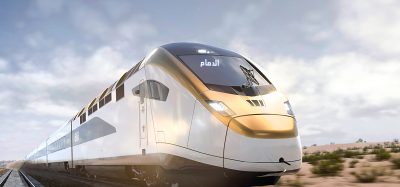Success and growth – the ÖBB way
Posted: 30 July 2007 | | No comments yet
ÖBB is on the way to renewal – and on the way to European achievement. One thing is clear to all members of the Group; ÖBB must be fit for European competition. This will require extensive work in major activities – ranging from the new main railway station of Vienna (the most important Central European transport hub of the future), to making sure they are number one on the Eastern and South-eastern European goods transport market. Some areas have already been achieved, but other areas remain incomplete.
ÖBB is on the way to renewal – and on the way to European achievement. One thing is clear to all members of the Group; ÖBB must be fit for European competition. This will require extensive work in major activities – ranging from the new main railway station of Vienna (the most important Central European transport hub of the future), to making sure they are number one on the Eastern and South-eastern European goods transport market. Some areas have already been achieved, but other areas remain incomplete.
ÖBB is on the way to renewal – and on the way to European achievement. One thing is clear to all members of the Group; ÖBB must be fit for European competition. This will require extensive work in major activities – ranging from the new main railway station of Vienna (the most important Central European transport hub of the future), to making sure they are number one on the Eastern and South-eastern European goods transport market. Some areas have already been achieved, but other areas remain incomplete.
ÖBB will turn Vienna into one of the European key transport hubs by 2013. An important element of this objective is the main railway station of Vienna which will be in operation by this deadline date. The Austrian federal capital is already an important transport hub – due to the numerous dead-end stations. However, Vienna is rather an end of the line station than a hub. This structural problem prevents through connections by railway between West, East, North and South – a problem that which has been in existence for 170 years. The main railway station of Vienna will correct this disadvantage and all key railway axes will be linked at one point and optimally connected with the Viennese city and regional transport systems. This will position Vienna at the crosspoint of the TEN corridors:
- TEN 17: Paris-Strasbourg-Stuttgart-Vienna-Bratislava
- TEN 22: Athens-Sofia-Budapest-Vienna-Prague-Nuremberg/Dresden
- TEN 23: Gdansk-Warsaw-Brno/Bratislava-Vienna-Venice.
More than 1,000 trains and 145,000 people a day will frequent the new main railway station of Vienna. In six years, it will restructure the rail transport far beyond the borders of Vienna. Rail travellers will experience a new quality and the region will become an economic incentive. The main railway station of Vienna will address new markets and connect people from many parts of Europe.
With an investment of €886 million, it is one of ÖBB’s largest infrastructure projects and, with its size, it goes far beyond the mere construction of a railway station hall. The project will increase the railway’s attractiveness compared with car and plane transport.
Above all, one prerequisite must be met to ensure the optimal benefits from the railway station; the development of the main axes leading to the future main railway station of Vienna – in particular, the West-East axis (Danube axis) and the Viennese North-South axis. The Western line between Vienna and Salzburg has already been developed for several years with high expenses. By 2013, a large part will be ready with four-way tracks and allow more than 600 train runs a day. A top train running speed of 200km/h has already been achieved on the sections – a real achievement for alpine regions. ÖBB is even making tests with 250km/h as future perspective.
Also, in Vienna, the connection of the Western line with the Southern line will be completed by 2013. Works for the ‘Lainzer Tunnel’ are fully under way and the multifunctional tunnel link will be an optimal supplement to the main railway station of Vienna.
The new North-South axis
Of equal importance is the development of the North-South axis from Vienna via Graz to Slovenia or Klagenfurt and Italy. The existing Southern line no longer meets the requirements. However, an efficient rail system is a decisive criterion for Austria’s position in the European economy: infrastructure depends on location quality, an area in which Austria has some catching up to do.
Hence, ÖBB is building the Koralm railway line between Graz and Klagenfurt and the Semmering base tunnel. Both projects will considerably increase the capacities of the North-South axis and notably shorten journey times. As part of the European TEN network, they will connect the South of Austria with the national and international economic hotspots. The developed railway axis will massively enhance the business location and result in a shift of transport from road to rail. In long-distance passenger transport, the number of passengers on the route is to increase from currently 6.6 million a year to more than 10 million, whilst in goods transport, the elimination of climbing gradients will allow higher tonnages.
From ‘transport drag’ to high-performance route
The historical railway line crossing the Semmering dates back to 1854 and, today, is still part of the Southern line and, therefore, one of Austria’s major railway axes. It is among the most heavily trafficked railway lines in Austria and imposes operational constraints:
- Due to the long journey time, above all, the passenger transport is no longer competitive with the car
- ‘Rolling road’ and double-deck coaches cannot operate due to profile limitations in the numerous tunnels
- Due to the steep climbing gradients, heavy freight trains must be divided or pulled by two locomotives resulting in additional operational expenditures and extra costs
- Due to slower speeds, less trains can be operated overall
- Numerous structures result in expensive maintenance of the route
- The narrow curve radii result in heavy wear of the rails, which makes maintenance more expensive
On the other hand, there is a growing demand for transport services on this important North-South axis – not least because of Slovenia joining the EU in 2004.
The new Semmering base tunnel is presently in the planning phase. With this tunnel, the journey time is to be reduced by at least 30 minutes. It will increase the efficiency of the Southern line and have positive impacts on people, environments and the economy. It will boost the efficiency of train operations as well as reduce energy consumption and maintenance costs.
€4.9 billion for the Koralm railway line
The Koralm railway line is presently the largest ÖBB infrastructure project. To this day, the connection of the central regions of Graz and Klagenfurt by rail has only been possible with a major detour. The Koralm railway line will be the first direct connection on rails. It will be part of the international rail transport corridor ‘Adriatic-Baltic axis’ – together with the Pontebbana, which has already been completed on Italian territory up to the border station of Tarvisio. This Adriatic-Baltic axis runs as international corridor from Bologna-Venice-Udine-Tarvisio-Villach-Klagenfurt-St.Andrä-Deutschlandsberg via Graz-Semmering-Vienna-Warsaw up to Gdansk. With the development of the Styrian Eastern line (Graz-Szentgotthard), also the market in the East will be directly connected with the Koralm railway line.
The key element of the Koralm railway line is the Koralm tunnel, which passes under the Koralpe and has given its name to the railway line. Until 2008, exploratory headings will be driven, with the plan to extend these to be the first tunnel tube starting from 2008. The Koralm tunnel is to be completed by the year 2018. The overall costs of the Koralm railway line will be ?4.9 billion by the time the project will be completed.
Europe’s most modern locomotive fleet
Efficient routes also require efficient trains. ÖBB has already set the course for this. By the end of 2007, ÖBB will own 382 Taurus locomotives – making it the most modern locomotive fleet in Europe. The newest generation Taurus 3 with its multi-system technology can be operated in most of Europe and hurdles the different electricity and safety systems in the individual countries. Thanks to these innovations, ÖBB can gradually remove the barriers on the way to Europe.
Positive first experiences point ÖBB in the right direction. They are already operating scheduled cross-border runs with the new locomotive between Lienz and Innsbruck via Fortezza (Italy) to Ceske Budejovice (Czechia), Budapest (Hungary) as well as Ljubljana and Dobova (Slovenia) and to several German cities.
Slovenian Railways (SZ) is also presently purchasing 20 Taurus 3 locomotives identical in construction, profiting from the same multi-system technology. On 10 December 2006, ÖBB and SZ started a joint deployment with each other’s railroad network. This demonstrates a successful European cooperation of two railway companies.
Production of ‘railjet’ has commenced
With the Taurus, ÖBB has already achieved the positive revolution in its locomotive fleet. However, in the passenger carriages area, this issue is yet to be tackled. Here, the key project of railjet has started. The new trains, with seven optimally designed carriages each, will set the standard in long-distance transport starting from 2008. ‘railjet’ also stands for a completely new market and service concept. This package is the core of the comprehensive modernisation and customer offensive in long-distance transport.
In a first tranche, ÖBB has ordered 23 railjet trains – the supplier is Siemens Austria. The investment volume is approximately €250 million. ÖBB is presently preparing the order of a second tranche with another 44 railjets.
ÖBB will achieve and present a new image for railjet. Shorter journey times and a pleasant travel experience in a modern ambiance for the customer as well as a perfect customer service will be its selling point.
Starting from 2008, the first railjets will be operated on the route Munich-Vienna-Budapest. In 2009, railjets will also be used on the route Vienna-Salzburg-Innsbruck-Feldkirch-Bregenz respectively Zurich.
First ICEs under ÖBB flag
Also, since December, another train of European format has been in operation. Together with Deutsche Bahn, ÖBB is preparing a vehicle pool of eleven ICEs. The first ICE trains under ÖBB flag are already operating between Vienna and Bregenz as well as between Vienna and Munich. Starting from December 2007, ÖBB and DB will offer daily ICE operations between Vienna and Frankfurt every two hours. From then on, the two railway companies will form their joint vehicle pool, in which DB will participate with eight and ÖBB with three ICE trains.
Railteam starts in 2007
These two new offers – railjet and ICE – form the basis for a successful participation of ÖBB in Railteam.
Railteam is an alliance of several European railway companies and is to start in December 2007. Railteam is to act as a counterbalance to similar cooperations of airlines such as Star Alliance and Skyteam.
The founding members of Railteam are seven railway companies in Germany (DB AG), France (SNCF), Belgium (SNCB/NMBS), The Netherlands (NS), Switzerland (SBB) and Austria (ÖBB) as well as the British Eurostar Group.
The main objective of this alliance is to strengthen the European high-speed transport compared with low-cost airlines. In a joint effort, the railway companies aim to standardise tariffs for cross-border transport, improve the safeguarding of connections between the individual trains, offer a uniform comfort standard (e.g. lounges in major railway stations) as well as coordinate frequent traveller programs.
Railteam’s route network includes the entire high-speed network of TGV as well as ICE connections in France and Germany. In addition, also the routes of these trains in Belgium, The Netherlands, Austria and Switzerland as well as the connections of Eurostar through the English Channel Tunnel to London are included in the network. Starting from December 2008, the connections of the ÖBB railjet will be added to this network. For ÖBB, it is natural to be active in the front line and, thus, make railway transport more European and help reduce the barriers.
Workshops along the way to Europe
The internationalisation of the ÖBB Group is already well advanced in the service area. ÖBB-Technische Services, the workshops of the ÖBB Group, are presently actively working on the development of a Europe-wide service network for the repair and maintenance of locomotives (Taurus/2016), power cars (Talent/Desiro) and components. Furthermore, service facilities are to be constructed in strategically important locations. This is to be achieved by entering repair and partnership contracts and by the mutual cooperation and possible joint ventures with service companies.
With the conclusion of a maintenance contract for 10 Taurus locomotives of the Hungarian State Railway MÁV, ÖBB could already achieve a major success on the international market. Apart from ÖBB-Technische Services, Deutsche Bahn and Siemens Integrated Services also had bid for this order.
For three years (with an option for a further three years), ÖBB-Technische Services will be responsible for the maintenance of the Hungarian State Railway’s Taurus fleet. Apart from service and maintenance, this all-inclusive contract also covers guarantee works and heavy maintenance, i.e. the major repair and service works. The works on the Hungarian locomotives will be carried out under the management of a supervisor in the MÁV workshops Budapest-Ferencváros and –Eszaki and the vehicle components will be reworked in the ÖBB plant in Linz.
Since the start of the ‘Taurus era’, ÖBB-Technische Services are responsible at ÖBB for the assembly and maintenance of all ÖBB Taurus locomotives. The resulting know-how has been bundled in the Taurus Competence Centre in Linz. From here, the European ambitions of ÖBB-Technische Services will be tackled. The conclusion of the maintenance contract with the Hungarian state railways has allowed ÖBB to make a successful start.
ÖBB has already concluded a similar contract with the Raab-Ödenburg-Ebenfurter-Eisenbahn (GySEV/ROeEE). The franchise contract covers repairs and maintenance of five Taurus locomotives. The strategic orientation of the ÖBB Group clearly shows that this was only the beginning and more initiatives will follow on the European markets. They have to follow as a consequence of internationalisation, which does not stop short at railway transport – with economic principles comparable to other industries.
Goods transport: market leader in Eastern and South-eastern Europe
In goods transport, ÖBB wants to become number one in Eastern and South-eastern Europe by 2010. Apart from the already existing network of interests and locations, opportunities for the expansion of the market shares are constantly being assessed. Despite the qualification as best bidder in the tender for privatisation of the Slovakian goods traffic railway company ZSSK Cargo, this project could not be positively concluded, as the Slovakian government has stopped the award procedures following the political change in 2006. Now, however, chances are good that the goods transport sector of the Hungarian State Railways (MÁV-Cargo) earmarked for privatisation can be taken on. ÖBB is assessing this opportunity.
Finally, the development of the network in the direction of Eastern and South-eastern Europe could be further accelerated with the terminal Oradea in Romania. The take-over of two companies also allowed entry on the Spanish market.
The highly increased internationalisation in goods transport was also observed in cross-border transports. Today, as much as 75% of all of ÖBB’s shipments go abroad. In goods transport, ÖBB presently has 73 associated companies in 23 European countries. With 93 million tons, ÖBB is Europe’s fourth largest rail freight company and the largest based on the population figure.
First rolling road in ‘real’ transit
The rolling road – the carriage of trucks and drivers by rail – is handled by a special ÖBB company in Austria. For the first time, ÖBB also offers a rolling road, which does not start and end in Austria. The starting point is in Regensburg (Germany) and the destination is Trento (Italy). The route across the Brenner, however, makes the new rolling road quite important. The aim of the new connection is to reduce the traffic load caused by road goods transport. The economic development of 2006 shows that the rolling road is the ideal solution to achieve this aim. With 275,000 trucks, ÖBB was able to put as much as 40% more trucks on rails compared to the previous year.
The reason for the success is ÖBB’s take-over of the marketing company Ökombi in the previous year and the restructuring of the offer. At the largest rolling road terminal in Wels alone – it is also the largest of its kind in all of Europe – ca. 116,000 trucks were loaded on the low-loader wagons. 24 trains of the rolling road leave this terminal daily and go to four destinations in Southern and Eastern Europe. Also, the routes Wörgl – Brenner (24 trains daily) and Trento – Wörgl (10 trains daily) are important connections of this combined transport system. The new connection clearly emphasises the internationality of the Austrian goods transport.
Therefore, the following can be said concerning the challenges in European railway transport: size increase is a decisive criterion for the success on the market, also for railway companies. ÖBB has achieved growth – both when it comes to market shares in goods transport and to the number of Taurus locomotives, which represents the most modern locomotive fleet of Europe. ÖBB will continue this way, as the objective is to become one of the top railways in Europe by 2010.
About the author
Martin Huber has been chairman of the ÖBB Group since January 2005. Before, the graduate business economist was on the board of the construction group Porr. At ÖBB, Martin Huber is in charge of 43,000 employees. In 2006, ÖBB was able to present a record balance sheet under his management; with an increase of eight million passengers and five million tons of goods.
Stay Connected with Global Railway Review — Subscribe for Free!
Get exclusive access to the latest rail industry insights from Global Railway Review — all tailored to your interests.
✅ Expert-Led Webinars – Gain insights from global industry leaders
✅ Weekly News & Reports – Rail project updates, thought leadership, and exclusive interviews
✅ Partner Innovations – Discover cutting-edge rail technologies
✅ Print/Digital Magazine – Enjoy two in-depth issues per year, packed with expert content
Choose the updates that matter most to you. Sign up now to stay informed, inspired, and connected — all for free!
Thank you for being part of our community. Let’s keep shaping the future of rail together!
Issue
Related topics
Cargo, Freight & Heavy-Haul, Infrastructure Developments, Rolling Stock Orders/Developments







